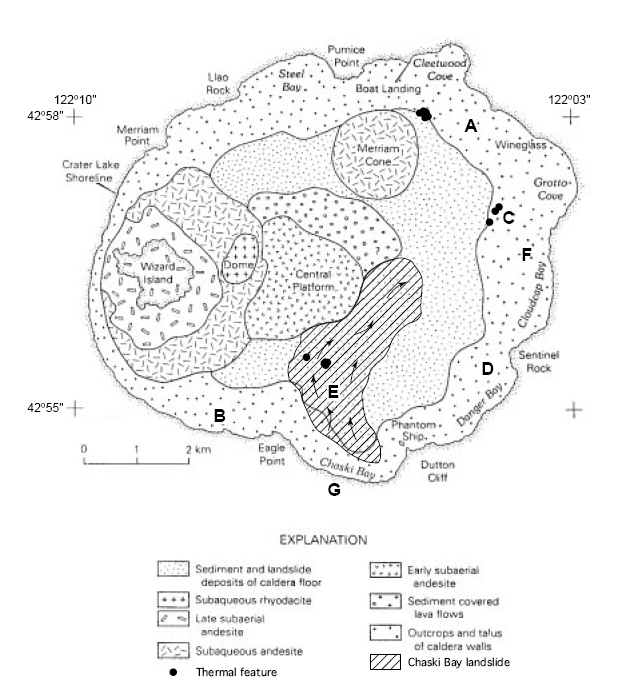Volcano and Earthquake Hazards in the Crater Lake Region, Oregon
Potential Hazards From an Eruption Beneath Crater Lake
Factors Controlling Explosivity of Eruptions in Bodies of Water
The presence of Crater Lake creates potential hazards from future eruptions that had not existed prior to formation of the caldera ~7,700 years ago. One such hazard is the violent mixing of lake water with erupting magma to produce a hydromagmatic eruption. Some famous eruptions became explosive when magma apparently mixed with shallow sea or lake water (e.g., Surtsey volcano, Iceland, 1964, described by Moore, 1985; Taal volcano, Philippines, 1965, described by Moore and others, 1966). In other eruptions, however, explosions caused by magma/water mixing have been less violent. Factors that determine how violently water and magma interact include the type of magma, its rate of extrusion, the degree to which the magma is fragmented by expanding internal gas bubbles, and water depth (Mastin, 1995).
FIGURE 3.—Geologic map of Crater Lake caldera floor. Modified after Nelson and others (1994). Geology inferred from bathymetry (Byrne, 1962), traverses and sampling by manned submersible, video from remotely operated vehicle, and dredged samples. Letters refer to specific bathymetric features listed in table 6.
Explosive water/magma mixing is most common in shallow water (a few meters to tens of meters deep) when magma extrudes rapidly and breaks apart into coarse particles before it is quenched. After contacting water, the magma can thermally fracture into micrometer-sized particles that transfer heat at explosive rates to generate steam (Wohletz, 1986). Eruptions into deep water, where the high pressure inhibits the expansion of steam, tend to be much less violent than those through shallow water. Except near the shoreline, the floor of Crater Lake is at depths that would inhibit explosions.
Slow rates of lava extrusion (~1 m3/s), typical of lava flows or silicic domes, also inhibit violent mixing with water. For example, at Kilauea Volcano, Hawaii, basalt has flowed slowly into the ocean for more than a decade with relatively little explosive activity. Extrusion of silicic domes into lakes or in shallow marine environments has been known to have produced minor explosions. A lava dome extruded onto the floor of Crater Lake could grow to sufficient height that eruptions could become explosive. Because the possibility of magma/water interaction is the dominant factor in determining explosivity for an eruption within the caldera, we consider all magma compositions to be capable of producing explosive activity from an eruption of modest volume.


